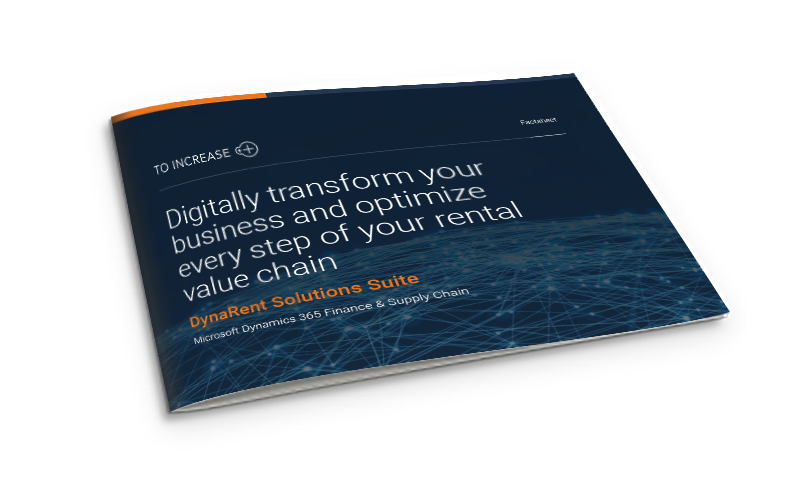The equipment rental market constantly evolves, and different technologies accompany each era. The industry is anticipating a spike with an estimated valuation of 145.22 billion US dollars by 2026, according to a Fortune Business Insights report.
With a growing market, technology in the rental space is advancing at an unprecedented rate, making it more efficient, accessible, and customer centric.
As innovators in the equipment rental technology market, we at To-Increase have catalyzed multiple global businesses to streamline operations with cutting-edge rental software in Dynamics 365.
Here are seven ways we believe technology is revolutionizing the equipment rental landscape in 2024 and beyond and how you can leverage it to boost your business's growth.
How is technology revolutionizing the equipment rental industry?
1. Online platforms and mobility
Equipment rental companies are adopting online platforms and mobile apps to provide remote access to vital information. Mobile connectivity helps ensure your assets are always fit for hire, with timely checks and upgrades, quickening the rental process.
A mobile app connects your field engineers, drivers, workshop workers, and technicians with access to data anytime and anywhere. It can intuitively guide on-site field service engineers through all the processes and provide all relevant data required to complete maintenance or delivery tasks.
You can also enhance customer experience by using an equipment rental customer portal with mobile capability. Such a portal offers data to customers on the rented equipment, current and past rentals, and rental totals.
2. Internet of Things
Internet of Things (IoT) technology is a network of interrelated devices that connect and exchange data with other IoT devices and the cloud. IoT-integrated equipment rental software allows you to remotely monitor the equipment's location, usage, and condition in real time.
With IoT connectivity, you can remotely monitor equipment in real time and collect data on equipment usage, performance, and location. IoT-enabled sensors can monitor equipment health, detect variances, and help plan preventive maintenance of assets, minimizing unplanned failures.
Additionally, it prevents theft and unauthorized use as you can continuously track the movement and usage of your assets. This allows you to ensure customer compliance with the rental agreements and invoice the customers accurately.
3. Artificial Intelligence and machine learning
Artificial intelligence (AI) and machine learning (ML) algorithms are becoming a more widespread technology in the equipment rental market. Using rental software with AI capabilities and ML algorithms, you can predict outcomes accurately.
AI-driven systems analyze historical rental data for demand forecasting, pricing optimization, and predictive maintenance. This lets you offer more personalized customer service and improve cross-selling and upselling opportunities.
4. Big data and analytics
Equipment rental companies deal with a vast amount of data, which can be a goldmine when interpreted in a meaningful manner. Analytics and business intelligence is a rising technology that helps translate big data into organized patterns and trends.
With rental analytics, you can gain insights into customer preferences, seasonal demands, market trends, utilization rates, and asset performance. This data-driven approach helps make informed decisions about fleet expansion, future investments, and equipment selection.
Industry-specific KPIs and analytics dashboards will offer valuable information to continuously enhance your processes and give you an edge over the competition.
5. Sustainability initiatives
Modern technology is aiding rental companies in tracking and improving the environmental impact of equipment through intelligent insights. For instance, advanced equipment rental software can identify the shortest and quickest route for planning equipment transport and delivery using geo-navigation capabilities, potentially lowering fuel consumption.
Fleet and supply chain management are also significant components influencing fleet optimization. This helps extend the equipment's lifespan, minimize waste, and maximize asset utilization.
Moreover, rental software transforms all documentation and communication on the digital platform, eliminating traditional paper trails, which benefits the environment.
6. GPS and scanning technology
Managing logistics can be a nightmare for globally operating equipment rental businesses that have equipment moving across different regions or countries. However, rental software with GPS integration that supports scanning can solve this challenge.
You can efficiently allocate serialized and non-serialized products with a global view of the fleet across multiple depots. Closely tracking the equipment's location with GPS allows you to fulfill rental orders economically with quicker transport planning.
With real-time scanning technology, you can handle equipment pick-ups, drop-offs, and mass returns from multiple locations. It guarantees smooth logistics and timely deliveries, enhancing customer experience.
7. Innovative invoicing methods
All equipment rental companies need technology supporting multiple and innovative invoicing processes. Invoice automation allows you to make quick decisions by rapidly calculating rental rates while allocating equipment for customer orders.
It can help you carry out rental project invoicing and multi-dimensional costing. It also enables you to understand the influence of the rental equipment on the overall project costs and match the internal and intercompany invoices to the project.
With such technology, you can track each project's rental cost and revenue and issue invoices based on different invoicing methods, calendars, and prices. You can combine multiple invoices into a single bill with consolidated invoicing, ensuring timely payments and improving cash flow.
What is the right technology for your equipment rental business?
Perpetually shifting technological trends can make you wonder what technology to focus on. From our experience, we can assure you that the right technology would address all business challenges while accommodating your rental business's long-term vision.
The quickest train to digital transformation is investing in cloud-based technology. Cloud software is easy to install and maintain, potentially transforming your end-to-end rental business using automation and flexibility. Cloud-based digitization is the future and will be worth 1 trillion US dollars by 2030 (McKinsey report).
Here are some steps to select the right cloud-based equipment rental software:
- Evaluate the problem areas in your business that impact revenue generation.
- Collaborate with different teams in your business on viable solutions to resolve these issues.
- Research your solution options based on your business criteria and needs.
- Calculate the costs (actual and opportunity) of equipment rental ERP.
- Discuss the business case, ROI, and operational impact with stakeholders.
Want to get started with cloud-based rental software?
If your long-term business strategy is to adopt cloud-based rental ERP software, which offers all the above technologies and much more, you can explore our rental software, DynaRent. It is a native extension of Microsoft Dynamics 365 for Finance and Supply Chain Management with comprehensive rental-specific capabilities built in.
You can learn more about DynaRent in the solution factsheet below.





